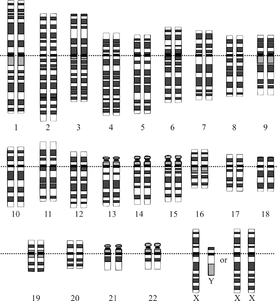NA methylation is a type of chemical modification of DNA that can be inherited without changing the DNA sequence. As such, it is part of the epigenetic code and is the most characterized epigenetic mechanism.
DNA methylation involves the addition of a methyl group to DNA — for example, to the number 5 carbon of the cytosine pyrimidine ring.
DNA methylation at the N5 position of cytosine has been found in every vertebrate examined. In humans, approximately 1% of DNA bases undergo DNA methylation. In adult somatic tissues, DNA methylation typically occurs in a CpG dinucleotide context; non-CpG methylation is prevalent in embryonic stem cells.[1][2]
In plants, cytosines are methylated both symmetrically (CpG or CpNpG) and asymmetrically (CpNpNp), where N can be any nucleotide.
The methylation status of specific cytosines can be determined using methods based on bisulfite sequencing.
DNA methylation is the addition of a methyl group to a piece of DNA. This can silence the gene resulting in loss of gene function.
It should be noted that some organisms, such as fruit flies, have virtually no DNA methylation.
In mammals
Between 60-70% of all CpGs are methylated. Unmethylated CpGs are grouped in clusters called "CpG islands" that are present in the 5' regulatory regions of many genes. In many disease processes such as cancer, gene promoter CpG islands acquire abnormal hypermethylation, which results in heritable transcriptional silencing. DNA methylation may impact the transcription of genes in two ways. First, the methylation of DNA may itself physically impede the binding of transcriptional proteins to the gene, thus blocking transcription. Second, and likely more important, methylated DNA may be bound by proteins known as Methyl-CpG-binding domain proteins (MBDs). MBD proteins then recruit additional proteins to the locus, such as histone deacetylases and other chromatin remodelling proteins that can modify histones, thereby forming compact, inactive chromatin termed silent chromatin. This link between DNA methylation and chromatin structure is very important. In particular, loss of Methyl-CpG-binding Protein 2 (MeCP2) has been implicated in Rett syndrome and Methyl-CpG binding domain protein 2 (MBD2) mediates the transcriptional silencing of hypermethylated genes in cancer.
In humans
In humans, the process of DNA methylation is carried out by three enzymes, DNA methyltransferase 1, 3a, and 3b (DNMT1, DNMT3a, DNMT3b). It is thought that DNMT3a and DNMT3b are the de novo methyltransferases that set up DNA methylation patterns early in development. DNMT1 is the proposed maintenance methyltransferase that is responsible for copying DNA methylation patterns to the daughter strands during DNA replication. DNMT3L is a protein that is homologous to the other DNMT3s but has no catalytic activity. Instead, DNMT3L assists the de novo methyltransferases by increasing their ability to bind to DNA and stimulating their activity. Finally, DNMT2 has been identified as an "enigmatic" DNA methyltransferase homolog, containing all 10 sequence motifs common to all DNA methyltransferases; however, DNMT2 does not methylate DNA but instead methylates a small RNA.
Since many tumor suppressor genes are silenced by DNA methylation during carcinogenesis, there have been attempts to re-express these genes by inhibiting the DNMTs. 5-aza-2'-deoxycytidine (decitabine) is a nucleoside analog that inhibits DNMTs by trapping them in a covalent complex on DNA by preventing the β-elimination step of catalysis, thus resulting in the enzymes' degradation. However, for decitabine to be active, it must be incorporated into the genome of the cell, but this can cause mutations in the daughter cells if the cell does not die. Additionally, decitabine is toxic to the bone marrow, which limits the size of its therapeutic window. These pitfalls have led to the development of antisense RNA therapies that target the DNMTs by degrading their mRNAs and preventing their translation. However, it is currently unclear if targeting DNMT1 alone is sufficient to reactivate tumor suppressor genes silenced by DNA methylation.
In plants
Significant progress has been made in understanding DNA methylation in plants, specifically in the model plant, Arabidopsis thaliana. Whereas in mammals methylation mainly occurs on the cytosine in a CpG context, in plants the cytosine can be methylated in the CpG, CpNpG, and CpNpN context, where N represents any nucleotide but guanine.
The principal Arabidopsis DNA methyltransferase enzymes, which transfer and covalently attach methyl groups onto DNA, are DRM2, MET1, and CMT3. Both the DRM2 and MET1 proteins share significant homology to the mammalian methyltransferases DNMT3 and DNMT1, respectively, whereas the CMT3 protein is unique to the plant kingdom. There are currently two classes of DNA methyltransferases: 1) the de-novo class, or enzymes that create new methylation marks on the DNA, and 2) a maintenance class that recognizes the methylation marks on the parental strand of DNA and transfers new methylation to the daughters strands after DNA replication. So far, DRM2 is the only enzyme that has been implicated as a de-novo DNA methyltransferase. DRM2 has also been shown, along with MET1 and CMT3 to be involved in maintaining methylation marks through DNA replication.[3] Other DNA methyltransferases are expressed in plants but have no known function (see the Chromatin Database).
Currently, it is not clear how the cell determines the locations of de-novo DNA methylation, but evidence suggests that for many, but not all locations, RNA-directed DNA methylation (RdDM) is involved. In RdDM, specific RNA transcripts are produced from a genomic DNA template, and this RNA forms secondary structures called a double stranded RNA molecules.[4] The double stranded RNAs, through either the small interfering RNA (siRNA) or micro RNA (miRNA) pathways, direct de-novo DNA methylation of the original genomic location that produced the RNA.[4] This sort of mechanism is thought to be important in cellular defense against RNA viruses and/or transposons both of which often form a double stranded RNA that can be mutagenic to the host genome. By methylating their genomic locations, through a still-poorly-understood mechanism, they are shut off and are no longer active in the cell, protecting the genome from their mutagenic effect.
http://en.wikipedia.org/wiki/DNA_methylation









